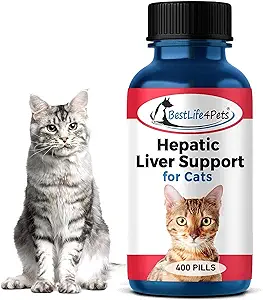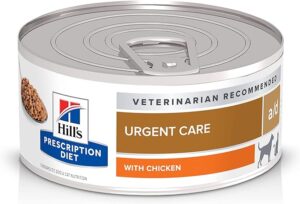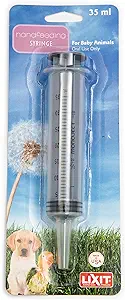What is jaundice in your cat?
Jaundice in cats is a symptom of yellowing of the skin, mucous membranes and whites of the eyes. This yellow discoloration is caused by an accumulation of the substance bilirubin. This substance is created in the process of replacing old red blood cells. Senescent red blood cells are normally broken down, resulting in the release of bilirubin. Then new red blood cells are made to replace the old ones. That is a normal process. The liver removes the bilirubin that has been released.
Is the liver unable to perform its normal functions for any reason? Or is more blood being broken down than should be? Then you may notice jaundice in your cat. In that case, bilirubin is not sufficiently removed and so bilirubin accumulates in the body. Since this fabric has an ocher-yellow color, the body will also get that color. Your cat has jaundice at that time.
Can a cat have jaundice?
Unfortunately, there are several known causes in cats that can cause a liver problem or increased blood breakdown. So yes, a cat can definitely have jaundice. Do you see a yellow color developing in your cat’s eyes, on thinly haired skin or in his mucous membranes such as his gums and tongue? Then it is wise that you contact your vet as soon as possible. Also evenings or weekends.
What Causes Jaundice in Your Cat?
In cats, the most common cause of jaundice is fatty liver disease. In addition, there are also bile duct infections, liver tumors or FIP (feline infectious peritonitis). Of course, there are also occasional other problems that can cause jaundice in your cat, but they are rare. We will explain the different causes in more detail later in this article.
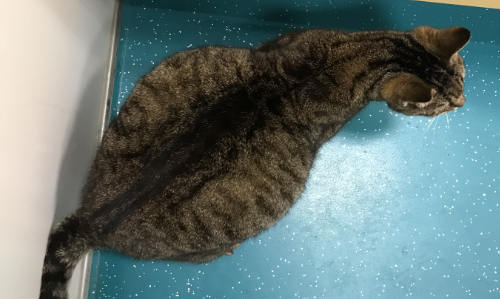
How do you recognize jaundice in your cat?
You can recognize jaundice mainly by the fact that your cat takes on a yellow color in its skin. This is mainly seen on thinly haired body parts such as the region in front of the ears, the abdomen and the anus. You can also see this clearly in the whites of your cat’s eyes, which have then acquired the yellow colour. And you can also see this reflected in his mucous membranes such as his gums and tongue.
What other symptoms do you see with jaundice in cats?
But usually there are other symptoms as well. Your cat usually doesn’t feel fit and therefore sleeps a lot. He eats worse and a cat with a liver problem usually loses a lot of weight. In addition, their urine is often darker than normal, but many owners do not notice this. Vomiting and diarrhea are also common in cats with liver problems. In very extreme cases, neurological problems such as “staring into nothingness” or spastic movements can be seen. Yet these are all vague complaints and so it is not possible to determine on the basis of this that he suffers from liver problems. The yellow color, however, is very specific for liver problems or increased blood breakdown.
How do you diagnose jaundice in your cat?
Since jaundice in itself is not a disease, we do not want to diagnose “jaundice”. The fact that your cat has the yellow color immediately confirms that your cat has jaundice. However, what we want to know is what causes this. And we need to do several studies for that.
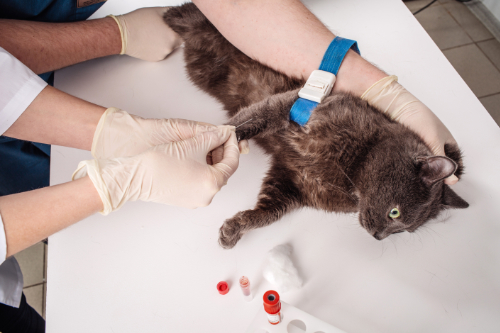
Blood test
We almost always start with a blood test if jaundice is seen in your cat. This allows us to determine how much of the various substances that have to do with your liver are present in your cat’s blood. This is necessary for the diagnosis, but also for later to see if the treatment is working. We also want to know how many red blood cells there are to see whether too many red blood cells have broken down. The problem is not in the liver, but in the blood cells. In that case, your liver cannot get rid of all those breakdown products fast enough. In addition, many cats with liver problems also have blood clotting problems. That is also often investigated.
Ultrasound of the abdomen
We also almost always perform an abdominal ultrasound to view the liver when jaundice was found in your cat. In this way we can diagnose liver tumors and also the disease Triaditis. This is a disease in which there is liver inflammation, pancreas inflammation and intestinal inflammation. Unfortunately, occasionally there is also a diagnosis of FIP, a viral inflammation of the liver and peritoneum. But in most cases we will see that a fatty liver has occurred. In such an abdominal ultrasound, a little tissue is usually also taken from the liver using a needle. That piece of tissue taken is then sent to a lab to get a diagnosis. That may take a few days. For example, in the case of a tumour, we want to know whether it is cancer and what type of cancer it is.
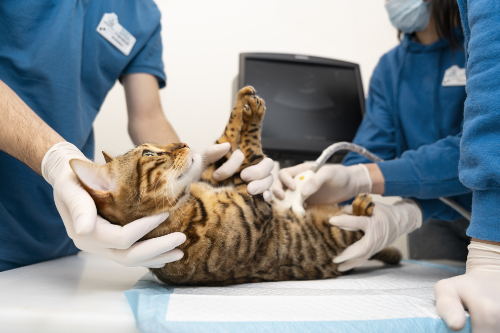
Fatty liver as a cause of jaundice in your cat
Jaundice in your cat due to fatty liver disease occurs when a cat has not wanted to eat for one reason or another. To get enough energy at that moment to keep his body functioning, your cat will very quickly break down his fat tissue to get energy. But then we run into a problem. Your cat’s liver is not able to get rid of so much fatty tissue at once. In his liver, therefore, that fat tissue “temporarily” accumulates to be able to get rid of it later. But with this temporary storage of fatty tissue in the liver, your liver can no longer perform its normal functions, and there are many of them, properly. As a result, many other mechanisms in your cat’s body also go wrong. If we don’t stop this process, your cat will die.
Bile duct inflammation or inflammation of the liver as a cause of jaundice in your cat
The bile ducts make the bile needed for the digestion of food. This bile also contains the bilirubin we talked about earlier. If the bile ducts are inflamed, the bile cannot be properly drained from the liver to the intestines via the bile ducts. As a result, the bilirubin accumulates in the body and jaundice occurs. Often they also have abdominal pain and diarrhea can play a role.
Liver tumors as a cause of jaundice in your cat
With liver tumors you sometimes have virtually no complaints. In other cases, the tumor will block liver function. The bile cannot be made properly or is not sufficiently drained. Or vital proteins are no longer made in the liver. All in all, the liver cannot function properly when there is a liver tumor. There are liver tumors that can still be treated with surgery or chemotherapy, but unfortunately some are not.
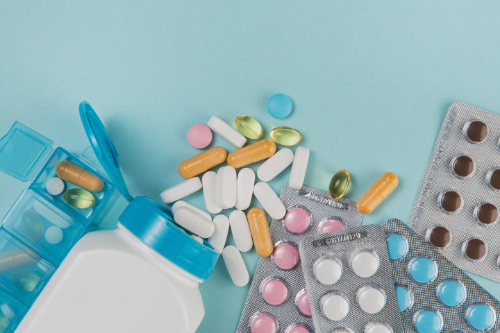
FIP (feline infectious peritonitis) as a cause of jaundice in your cat
FIP is a viral infection that causes inflammation in the liver and peritoneum. This is a virus that has mutated in the body of the cat with FIP. The original virus is a virus that occurs with some regularity in cats and causes diarrhea. It’s terrible, but the occurrence of this disease is unfortunately a matter of enormous bad luck. It cannot be cured or slowed down to date. In general, these are relatively young cats that can get very vague complaints. Some of the cats with FIP also get an enormously swollen abdomen because fluid accumulates in the abdominal cavity. Usually they also have a fever.
Anemia as a cause of jaundice in your cat
Anemia in cats is not very common. But it is still important to name it as a cause of jaundice in your cat. The combination of anemia and jaundice occurs when there is accelerated blood breakdown in cats. This can be caused by a parasite, a bacteria or because your cat’s antibodies attack its own blood. Because the red blood cells break down, they have a reduced amount of oxygen transporters in their blood and are therefore quickly exhausted as soon as they have to do something.
What treatment does a cat with jaundice need?
Which treatment is needed depends of course on the cause of your cat’s jaundice. Below we discuss the treatment for each medical condition in general. But of course, your vet may decide that a different treatment plan is better for your cat.
Fatty liver
If fatty liver is the cause of your cat’s jaundice, it is important that your cat gets food to prevent the breakdown of its body’s own fatty tissue. This gives the liver the chance to get rid of the stored fat. To get your cat to eat again, we often give appetite stimulants, medication to prevent nausea and in severe cases we take them to the clinic to give them an IV and force-feed them. Some cats also need pain relief. In very serious cases, we give a cat a feeding tube that allows us to introduce liquid food into the stomach through that tube without your cat noticing it.
Hepatitis or bile duct inflammation
In this case we often give them very strong anti-inflammatories and if necessary also antibiotics. This way, hepatitis and thus jaundice in your cat is counteracted. In this case too, we give medication to suppress certain symptoms. So, for example, nausea or diarrhea. And possibly extra painkillers if they are in a lot of pain. We often take serious cases into practice in order to be able to guide them very well in their recovery.
liver tumors
If a liver tumor is found, it must be determined what form of liver tumor it is. On the basis of this, it can be determined whether treatment is possible and what the chance of recovery is. All in all, it is an intensive and expensive process that your cat will have to go through in order to stay alive. And not all owners choose to go through that journey. In that case, you can still try to cause a temporary revival by giving your cat prednisone. In some cases, this temporarily shrinks the tumor, hopefully reducing your cat’s jaundice. But with the emphasis on temporary! Because after a few weeks to months, the tumor will grow again and euthanasia is the only animal-friendly solution.
FIP
Many studies are underway to cure FIP or at least slow it down. To the best of our knowledge, no effective treatment or inhibition of this disease has yet been possible. Incidentally, a treatment that is given in a trial for a new treatment does work. But no significant treatments are yet possible as far as we know. If your cat received this diagnosis, you can consult with your vet to see if any tests are currently being carried out in which your cat can participate in the hope that this will cure him of his FIP and therefore of your cat’s jaundice. However, his chances are unfortunately minimal.
Anemia
If your cat has jaundice as a result of anemia, the cause of the blood breakdown must be found out. However, the cause is often only clear after a few days and that time is not there to wait. That is why in most cases both prednisone, antibiotics and antiparasitic agents are given. After a few days, the blood test is repeated to see if the breakdown of the blood has stopped. Once the results of the examination are in and a diagnosis has been made, the medication that is not needed will be stopped. Sometimes it is necessary to continue giving medication for life and sometimes a temporary course is enough to become a healthy cat without jaundice again.
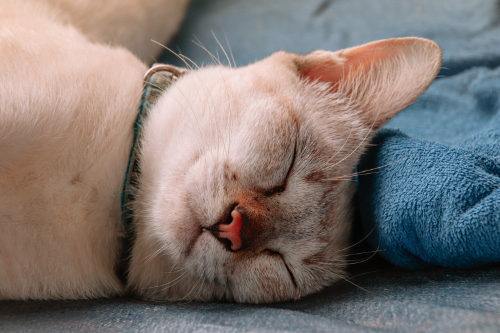
What is the best food to give to a cat with liver problems?
You can treat a fatty liver in your cat yourself by more or less forcing your cat to eat. By letting him eat you ensure that he has less need to break down his own fat tissue. His liver then has to work less hard and can keep up. It is of course important to provide a very tasty diet. Otherwise he won’t eat it anyway since he doesn’t feel well.
But the food must also contain little protein, but the proteins it contains must have a high quality. In addition, it is wise to give an energy-rich diet, but preferably not with a lot of fats. In this case, this energy should best come from carbohydrates. But if you can’t buy hepatic catfood, it is always better to give him, for example, boiled chicken breast (for human consumption) than that he does not eat at all. You can also try to support his liver with BestLife4Pets Hepatic Cat Liver Support.
However, many cats prefer to eat canned wet food. In that case you can make this a little warm so that your cat is just a little more inclined to eat. Or dilute it with water and inject it into its mouth with a syringe. See below for an explanation of how to do this. You can use Hill’s Urgent Care for this. It contains a lot of energy in a small amount of food.
How can you force-feed your cat?
It sounds very like, “force-feeding.” I always think of those geese that get a tube rammed in the throat. Fortunately, we work in a more animal-friendly way. Although your cat really doesn’t feel like it, it is vital that he gets food. So you will also have to switch off your emotion a bit.
Force-feeding means feeding your cat with a syringe about every two hours. You can dilute each feed with water and make a thick soup. Let the chunks soak if needed or use your blender if necessary. You suck up this nutrition in a 10ml syringe. If necessary, you can make the syringe exit slightly wider if you cannot get the made food through it. By getting about 10ml every 2 hours you are already well on your way. If he allows it, you can give him more food. Try to go as far as getting him a full amount of healthy cat food in 24 hours. In most cases, your cat will become clearly fitter again after about 3-4 days.
More about fatty liver as a cause of jaundice in your cat
Since fatty liver is the most common cause of jaundice in cats, we will provide some more information about fatty liver in cats below.
How long does it take for a fatty liver to recover?
Unfortunately, that depends on how bad the fattening is. Did the problem only last for a day? Then he will probably be back on his feet soon. But had he eaten virtually nothing for a week? Then it could take a week or so. It also depends on how much overweight your cat was before he got sick. An extremely overweight cat will take longer to recover than a normal weight cat. But in all cases it feels too slow for you. Have patience!
When do you put a cat with fatty liver to sleep?
There must be a very good reason for that. If a cat with a fatty liver does not recover, we usually place a feeding tube first. This is a tube that goes through the nose to the stomach. We can then provide nutrition through that tube. In addition, we give medication to support your cat as much as possible to feel comfortable again. So medication against nausea, against stomach ache or appetite stimulants. Whatever he needs. At that time, it is therefore necessary in most cases to have your cat admitted to your vet’s practice. The treatment can sometimes take a long time, but is usually successful.
We actually only opt for euthanasia when a cat does not want to cooperate with a treatment in the clinic and the owner also fails to force-feed and give the medication at home. Of course we also look at the age and the cause of the problem. But unfortunately we sometimes also look at what an owner can afford. Because a treatment is very time consuming for both the vet, the assistant and the owner. All in all, it will be quite a pricey affair.
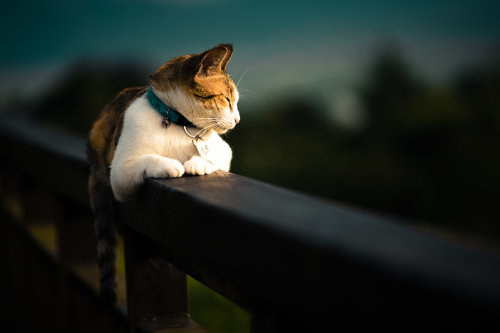
What prognosis does a cat with fatty liver disease have?
Although it often takes several weeks, most cats can get rid of their fatty liver. to recover. It all depends on how overweight your cat was and how serious it was. But it certainly doesn’t often end in death.
How can you prevent fatty liver disease in your cat?
Complete prevention is not possible. But making sure your cat doesn’t become overweight will go a long way. In addition, it is important to keep a close eye on whether your cat is eating enough. Does he not eat himself for a day? Then immediately try to get him to eat some food. At such a moment it doesn’t really matter what he eats, as long as he eats. So if he doesn’t eat his own kibble for a day, try if he wants to eat a slice of meat for bread. It is not healthy for him, but this way you prevent him from ending up in the vicious circle of fatty liver.
Good luck!
Although it might take a little longer than you like, we hope your cat will feel better soon. Good luck for the both of you!

